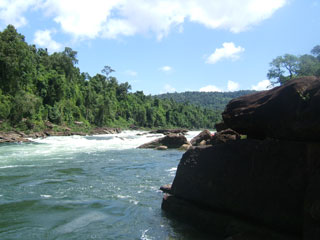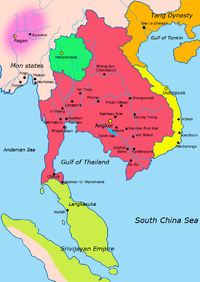Thursday, October 29, 2015
"Killing Fields" Lure Tourists in Cambodia
The sight of 8,000 human skulls in a glass shrine stuns visitors into silence.
Outside, where cattle usually graze, human bones sometimes come unearthed after heavy rains.
SHARE
RELATED
In Cambodia, nine miles (14.5 kilometers) from Phnom Penh, the "killing fields" of Choeung Ek have become a tourist attraction, horrifying and fascinating. Choeung Ek is one of thousands of other such sites around the country where the Khmer Rouge practiced genocide during the late 1970s.
Pol Pot Cambodia, 175-1979 2,000,000 Deaths
An attempt by Khmer Rouge leader Pol Pot to form a Communist peasant farming society resulted in the deaths of 25 percent of the country's population from starvation, overwork and executions.
Pol Pot was born in 1925 (as Saloth Sar) into a farming family in central Cambodia, which was then part of French Indochina. In 1949, at age 20, he traveled to Paris on a scholarship to study radio electronics but became absorbed in Marxism and neglected his studies. He lost his scholarship and returned to Cambodia in 1953 and joined the underground Communist movement. The following year, Cambodia achieved full independence from France and was then ruled by a royal monarchy.
|
By 1962, Pol Pot had become leader of the Cambodian Communist Party and was forced to flee into the jungle to escape the wrath of Prince Norodom
Tuesday, October 27, 2015
Geography - Koh Kong, Cambodia
Geography
Koh Kong province is 11,160 square
kilometres big. It's located in the West of the country and is bordering
to the North with Pursat, to the East and South with the Gulf of
Thailand and to the West with
|
Introduction about Koh Kong
Introduction
Koh Kong is the most southwestern
province of Cambodia. It is one of the biggest provinces in the whole
country with a long undeveloped coastline and a mountainous, forested
and largely inaccessible interior, which embraces part of the Cardamom
Mountains, the biggest coherent rainforest of Southeast Asia. Its
tourist attractions include abundant wildlife; big waterfalls and
casinos on the border to Thailand, while an Export Processing Zone and
new port facilities are being developed for international trade.
List of Prime Ministers of Cambodia
List of Prime Ministers of Cambodia
From Wikipedia, the free encyclopedia
 |
| This article is part of a series on the politics and government of Cambodia |
| Foreign relations |
Related issues[show]
|
Constitutionally the Prime Minister is required to be a member of the Parliament. He must also gain their approval through a resolution before an official appointment by the King can take place. The traditional swearing-in ceremony takes place at the royal palace where the Prime Minister-elect has to take an oath of office in front of the King and the two Patriarch monks.
Incumbent Hun Sen has held the position since 14 January 1985 (30 years, 281 days).
Religion and Beliefs
Theravada Buddhism is the religion of virtually all of the
ethnic Khmers, who constitute about 90% or more of the Cambodian
population. Buddhism originated in what are now north India and Nepal
during the sixth century B.C. Theravada Buddhism is a tolerant,
non-prescriptive religion that does not require belief in a supreme
being.
Its precepts require that each individual take each individual take full responsibility for his own actions and omissions.

Buddhism is based on three concepts: dharma (the doctrine of the
Its precepts require that each individual take each individual take full responsibility for his own actions and omissions.
Buddhism is based on three concepts: dharma (the doctrine of the
Thursday, October 22, 2015
List of monarchs of Cambodia
Cambodia (68–1431)
Funan Kingdom (68–627)
| Order | King | Personal Name | Reign |
| 01 | Queen Soma | Liǔyè (Traditional Khmer Call |
Vietnamese occupation and the PRK (1979–93)
Main articles: People's Republic of Kampuchea and Cambodian–Vietnamese War
See also: Cambodian humanitarian crisis
On 10 January 1979, after the Vietnamese army and the KUFNS
invaded Cambodia, the new People's Republic of Kampuchea (PRK) was
established with Heng Samrin as head of state. Pol Pot's Khmer Rouge
forces retreated rapidly to the Thai border. The Khmer Rouge and the PRK
began a costly struggle that played into the hands of the larger powers
China, the United States and the Soviet Union. A civil war was imposed
on impoverished Cambodia that displaced 600,000 Cambodians to refugee
camps along the border between Thailand and Cambodia.[143] The new regime murdered tens of thousands of people.[144][145]Social and cultural implications of the regime
Thousands starved or died of disease during the evacuation and its
aftermath. Many of those forced to evacuate the cities were resettled in
newly created villages, which lacked food, agricultural implements, and
medical care. Many who lived in cities had lost the skills necessary
for survival in an agrarian environment. Thousands starved before the
first harvest. Hunger and malnutrition—bordering on starvation—were
constant during those years. Most military and civilian leaders of
Democratic Kampuchea (Khmer Rouge era) (1975–79)
| This section needs additional citations for verification. Please help improve this article by adding citations to reliable sources. Unsourced material may be challenged and removed. (November 2008) |
Main articles: Democratic Kampuchea and Khmer Rouge rule of Cambodia
Flag of Democratic Kampuchea
Flag of the Communist Party of Kampuchea
French colonial period (1863–1953)
Main articles: French Protectorate of Cambodia and French Indochina
French Indochina in 1913.
Dark ages of Cambodia (1431–1863)
Main article: Dark ages of Cambodia
Flag of Cambodia pre-1864.
Epigraphy in temples, ends in the third decade of the fourteenth, and does not resume until the mid-16th century. Recording of the Royal Chronology discontinues with King Jayavarman IX Parameshwara (or Jayavarma-Paramesvara) - there exists not a single contemporary record of even a king’s name for over 200 years. Construction of monumental temple architecture had come to a standstill after Jayavarman VIIth reign. According to author Michael Vickery there only exist external sources for Cambodia’s 15th century, the Chinese Ming Shilu annals and the earliest Royal Chronicle of Ayutthaya.[99][100] Wang Shi-zhen (王世貞), a Chinese scholar of the 16th century, remarked: "The official historians are unrestrained and are skilful at concealing the truth; but the memorials and statutes they record and the documents they copy cannot be discarded."[101][102]
The central reference point for the entire 15th century is a Siamese intervention of some undisclosed nature at the capital Yasodharapura (Angkor Thom) around the year 1431. Historians relate the event to the shift of Cambodia's political centre southward to the region of Phnom Penh, Longvek and later Oudong.[103][104]
"As Siam became Cambodia’s primary nemesis after the demise of Angkor, it put an end to the pattern of ambivalent sovereignty that Cambodia’s imperial experiment on its western frontier had so effectively prolonged."[105]
"Longvek, capital of Cambodia"
Khmer Empire (802–1431)
Main article: Khmer Empire
Archers mounted on elephants
Map of South-east Asia c. 900 AD, showing the Khmer Empire in red, Champa in yellow and Haripunjaya in light Green plus additional surrounding states.
Chenla Kingdom (6th century – 802)
Main article: Chenla Kingdom
Ancient Khmer script
Funan Kingdom (1st century AD – 550)
Main article: Kingdom of Funan
Map of Funan at around the 3rd century.
Prehistory and early history
Main article: Early history of Cambodia
Carbon 14 dating of a cave at Laang Spean in Battambang Province, northwest Cambodia confirmed the presence of Hoabinhian stone tools from 6000-7000 BC and pottery from 4200 BC.[26][27]
History of Cambodia 2
The history of Cambodia, a country in mainland Southeast Asia, can be traced back to at least the 5th millennium BC.[1]
Detailed records of a political structure on territory, what is now
modern day Cambodia first appear in Chinese annals in reference to Funan, a polity that encompassed the
Monday, October 19, 2015
The History of Angkor.
The History of Angkor.
" Angkor is the name of the ancient city where the groups of
temples were built, Angkor Wat is the name of a grestest temple in
Angkor. "
|
Phnom Penh | History | Cambodia - Canby Publications
A Brief History of
Phnom Penh
People have inhabited parts of Southeast
Asia since the early Stone Age, and the ancestors of the Khmer people
have been in the area for at least
5000 years, perhaps much longer, but there is no firm evidence of
settlements in the Phnom Penh area prior to about 2000 years ago.
Though
probably an active settlement in Cambodia's golden age of Angkor
(9th-15th century AD,) Phnom Penh does not enter the historical record
until after it became the Khmer capital in the mid 15th century AD. At
the time it was known as Chaktomuk - the 'Four Faces' - so called for
its location at the four-branched confluence of the Mekong River. The
chaktomuk is a riverine crossroads in the heart of Cambodia with the
Tonle Sap River running northwest to the old Angkorian capital, the
Mekong River north to Laos and branches south to the delta and the
South
China Sea. Phnom Penh
Sunday, October 18, 2015
Khmer Rouge rule of Cambodia
The Khmer Rouge period (1975–1979) refers to the rule of Pol Pot, Nuon Chea, Ieng Sary, Son Sen, Khieu Samphan and the Communist Party of Kampuchea over Cambodia, which the Khmer Rouge renamed as Democratic Kampuchea.
The four-year period cost approximately 2 million lives through the combined result of political executions, disease, starvation, and forced labor.[1][2][3][4] Due to the large numbers, the deaths during the rule of the Khmer Rouge are commonly known as the Cambodian Holocaust or Cambodian genocide. The Khmer Rouge took power at the end of the Cambodian Civil War and were only toppled after the invasion of Cambodia by the neighbouring Socialist Republic of Vietnam in the Cambodian–Vietnamese War. Most of Cambodia remained under Vietnamese occupation for over a decade.
The four-year period cost approximately 2 million lives through the combined result of political executions, disease, starvation, and forced labor.[1][2][3][4] Due to the large numbers, the deaths during the rule of the Khmer Rouge are commonly known as the Cambodian Holocaust or Cambodian genocide. The Khmer Rouge took power at the end of the Cambodian Civil War and were only toppled after the invasion of Cambodia by the neighbouring Socialist Republic of Vietnam in the Cambodian–Vietnamese War. Most of Cambodia remained under Vietnamese occupation for over a decade.
Subscribe to:
Comments (Atom)
























